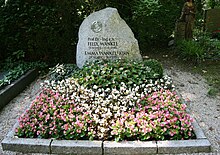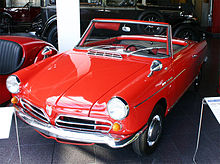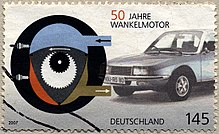Felix Wankel
Felix Heinrich Wankel (born August 13, 1902 in Lahr ; † October 9, 1988 in Heidelberg ) was a German businessman and self-taught mechanical engineer and inventor of the Wankel engine named after him .
youth
Wankel was the only child of forester Rudolf Wankel and his wife Gerty, nee Heidlauff. The father died in the First World War in 1914 , so that the family moved to Heidelberg the following year . After attending high schools in Heidelberg, Donaueschingen and Weinheim , which he left without a degree in 1921, Wankel began training as a publishing clerk with the Heidelberg publisher Carl Winter. There he was dismissed in 1926 due to economic problems.
While still at school, Wankel joined the philosophy professor Arnold Ruge in Heidelberg , who headed the local branch of the German-Völkischer Schutz- und Trutzbund (DSTB) and was known for his anti-Semitic speeches. Wankel put up leaflets for the group around Ruge and finally became a member of the DSTB in 1921. In retrospect, he explained his anti-Semitic engagement in the 1980s as crude fun, which gave the feeling of doing something good for Germany at the same time.
Formerly a National Socialist
Wankel had already filled out a membership card for the National Socialist German Workers' Party (NSDAP) in 1922 , the first local branch of which was founded in Heidelberg in March of the same year, but was soon banned. In 1926 he joined the NSDAP a second time. Politically, Wankel was primarily active by leading youth groups through which he wanted to inspire young people for ethnic-nationalist goals. He founded groups like Heia Safari (after the battle cry of the Schutztruppe for German East Africa ) and the Greater German Youth Armed Forces and was a youth leader in various organizations such as the NSDAP-affiliated Schilljugend , a paramilitary "Wehrjugendbund" around the former Freikorpsführer Gerhard Roßbach . Wankel saw the attractiveness of his groups in the technical innovations he developed, such as "light guns", signal transmitters, Morse code devices, field telephones and mine throwers, which were used in paramilitary terrain games. Gifted with an ingenious spatial imagination, the self-taught and self-proclaimed non-mathematician ("with the four basic arithmetic operations it stops with me") was enthusiastic about the world of machines, especially combustion engines , at an early age .
The youth movement was such enthusiasm for technology foreign. The Austrian Leopold Plaichinger, materials chemist at Bayerische Motorenwerke (BMW) and active National Socialist, arranged for Wankel to meet Adolf Hitler in the summer of 1928 to talk about a stronger technical orientation in youth education. Via Plaichinger, Wankel also came into contact in 1927 with the manufacturer Wilhelm Keppler , who was Hitler's economic advisor and who was to become a great sponsor of Wankel. While Keppler and Plaichinger were organizing meetings of business representatives with leading National Socialists, Heinrich Himmler also visited Wankel in his Heidelberg workshop, where he had the "light rifle" demonstrated and discussed the construction of gas-powered field kitchens that could be converted into flamethrowers .
Wankel's mother was involved in setting up the local NSDAP group in Lahr and hosted speakers from the party such as the Baden Gauleiter Robert Wagner . Wankels rejoined the NSDAP in October 1926 in the local group Lahr, and at a party event he met his future wife Emma, the sister of the NSDAP local group leader in Lahr. In 1931 Wagner appointed Wankel Gauleiter of the Hitler Youth (HJ) in Baden. In his new office, Wankel tried to anchor technical-militaristic training, but this also fell out with Wagner, who wanted the Hitler Youth to have a political orientation instead of a military one like Wankel. Wankel subsequently took a public position against Wagner, against whom allegations of corruption had been circulating since the late 1920s , and went so far as to accuse Wagner of having syphilis . At the end of 1931 Wagner withdrew from Wankel the Gauleitung of the Hitler Youth and initiated a party exclusion procedure, which was successful in October 1932. Wankel, who anyway sympathized with the more socialist wing of the NSDAP around Gregor Strasser , then founded the NSDAP spin-off Lahrer Notgemeinschaft and the newspaper Alemannische Grenzlandnachrichten , which heightened the corruption allegations against Wagner. During this time he stayed several times at the Munich party headquarters and claimed in Lahr that he was now working for the Reichsführer SS .
The National Socialist " seizure of power ", however, consolidated Wagner's position. He had Wankel arrested in March 1933. While Wankel continued to work on his first rotary piston machine in the Lahr official prison, Wankel's environment tried to find advocates for him and convinced the chief designer at Daimler-Benz , Hans Nibel , to stand up for Wankel. But only Wilhelm Keppler was released from prison in September 1933 by having Hitler send a personal telegram to Wagner that Wankel should be released immediately because of the importance of his technical work.
With this episode after the Second World War , Wankel stylized himself as a victim of National Socialism , but, according to the historian Marcus Popplow, without ever distancing himself from the militaristic, anti-democratic and racist basic features of National Socialist ideology . There was no question in 1933 that Wankel was a staunch National Socialist. In the 1950s, Keppler described Wankel as a “cleanliness fanatic” who could not ignore the corruption in the Gau leadership. Despite Wankel's tense relationship with the NSDAP and other party organizations after his imprisonment, Keppler managed to find support for him in the context of armaments policy. In 1937 Wankel submitted an application for re-entry into the NSDAP, which was rejected. Again on the recommendation of Keppler, however, he was accepted into the SS with effect from August 1, 1940 with the rank of Obersturmbannführer , but two years later he was excluded again for reasons that have not yet been clarified.
First ideas about the "rotary piston"
On a three-wheeled vehicle with a 2-cylinder V-engine (“devil's beetle”) built in 1924 with friends in the Paki company (backyard workshop named after his friend and colleague Paul Kind ), the “shaking” (the free mass forces) bothered him so much, that the idea of rotary piston combustion engines became an obsession for him.
With this, Wankel began the systematic search for a suitable design for such an engine. This had to enable a two-stroke, or better still a four-stroke, combustion process and be spatially "sealable". During his search, Wankel found that a large number of inventors (including James Watt ) had already dealt with the idea of a rotary piston machine. In addition, there were thousands of options for the design of the work spaces and pistons. Another extremely difficult hurdle was the sealing of the various gases between the working spaces of the engine and the distribution of the lubricants between surfaces that slide on each other at high temperatures and speeds. By the late 1920s, Wankel had discovered that it was gas pressure that pressed the seals in a conventional engine against the cylinder wall. Through this revolutionary discovery, Wankel achieved a certain degree of popularity and in the thirties was given the title of "Germany's first sealer" or "Reich sealer".
In the period that followed, Wankel deepened his experiments with rotary valve controls , an alternative gas exchange control to the known valves. After giving up the Heidelberg workshop for financial reasons, he moved to Lahr in order to put the theory of these control components into practice in a test workshop in his mother's house. It was there that the idea for the DKM 32, a rotary piston engine that was patented in 1933, was born. The engine only ran for a short time, but was suitable as a compressor . It delivered 5 bar pressure at 1000 rpm, which was due to the first three-dimensional sealing boundary. This knowledge led to a research contract with BMW in Munich in 1934 on rotary valve controls for conventional gasoline engines .

From 1936 Wankel worked with the Reich Aviation Ministry . For this purpose he founded the Wankel-Versuchs-Werkstätten (WVW) in Lindau on Lake Constance . There he led u. a. for the German Research Institute for Aviation (DVL) Berlin the rotary valve control for aircraft engines for practical use. This rotary valve control was also used for other purposes. The Junkers JUMO KM 8 torpedo motor had a rotary valve control developed by Wankel. Further developments for the rotary piston engine followed , none of which, however, met Wankel's expectations. Wankel also constructed new types of boat shapes ("Zisch"), which aroused the interest of the naval command and the Waffen SS . The Reich Aviation Ministry supported Wankel until 1945 with millions.
After 1945
After the Second World War , the workshops were dismantled by French occupation troops in 1945 and Wankel was briefly imprisoned for his activities. After his release, he was temporarily banned from research.
With funds from the Goetze AG company in Burscheid, Wankel set up the new Technical Development Center (TES) in his private home in Lindau (Lake Constance) in 1951 (moving to an independent new building on the shores of Lake Constance in 1960). In the same year, the first contacts were made with NSU about the development of a rotary loader. Finally, in April 1954, he succeeded in inventing the basic invention for the motion sequence of the only rotary piston engine that had been mass-produced to date, the Wankel engine .
A compressor based on the Wankel principle was used by NSU in 1956 for world record drives. Initially developed as a rotary piston engine (DKM 54), with both the trochoid (the space in which the piston is located) and the piston rotating around its own axis at different speeds, promising test bench runs were carried out in 1957. The following year the engine became the Rotary piston engine redesigned (fixed housing with water cooling, now only the oil-cooled piston moved; the so-called "kinematic reversal" was not done by Felix Wankel, but by NSU engineer Hanns-Dieter Paschke . Wankel and Paschke had differences since then). Wankel described this kinematic transformation of his idea with the words: "You have made a plow horse out of my racehorse." The NSU chairman of the board of Heydekampf, however, countered: "If we at least had the plow horse!" The first company to have a license to build Wankel engines acquired from NSU was the US armaments company (including aircraft engines) Curtiss-Wright . Contrary to the agreements with NSU, Curtiss-Wright announced at the end of November 1959 what had been a secret, up to this point in time, fluctuating development, which forced NSU to go public (which was actually only intended later).
On January 19, 1960, the rotary piston engine was presented to experts and the press for the first time at a VDI meeting in the Deutsches Museum in Munich, and in the same year the KKM 250, the first practical rotary piston engine in a converted NSU Prinz, was demonstrated. During this time, the designation "Wankel engine" for the rotary piston engine, which NSU had originally introduced as "Engine according to the NSU / Wankel system", was also consolidated. At the IAA 1963, the NSU company presented the NSU Wankel-Spider, the first passenger vehicle to be produced with a Wankel engine, which went into series production in 1964. NSU achieved the greatest sensation in August 1967 with the extremely modern NSU Ro 80 (115 hp), which had a 2-disk unit (an engine with two rotary pistons) and was the first German vehicle to be voted "Car of the Year" in 1967 .
Wankel's business success was secured by numerous license agreements around the world. As early as 1958, Wankel and partners founded "Wankel GmbH", which was supposed to ensure that Wankel had sufficient financial participation in the marketing of the engine. The licensees included Daimler-Benz (from 1961), General Motors (from 1970) and Toyota (from 1971). The share of the Wankel GmbH in the license income was 40, later 36 percent. In 1971 Wankel sold his shares in the exploitation of the licenses for 50 million DM to the English conglomerate Lonrho , and the following year he bought back his self-designed "Technical Development Center" (TES) in Lindau from the Fraunhofer Society .
From 1986 Felix Wankels Institute cooperated with Daimler-Benz AG. Daimler-Benz took over the running costs and received the rights to the research results. He sold his institute to Daimler-Benz for 100 million DM.
Personal and estate

Wankel was married to Emma ("Mi") Kirn (* 1905) from 1936, who died in 1975. The marriage remained childless.
Wankel never had a driver's license because he was extremely myopic. However, he was the owner of an NSU Ro 80 (with a rotary engine as standard), in which he was chauffeured. After selling his shares in Lonrho, Wankel set up the Felix Wankel Foundation based in Heidelbergs Philosophenweg 17, his retirement home. He was a great animal lover, and so the foundation still awards prizes for exceptional achievements in animal welfare and supports the research prize of the International Society for Farming Animal Husbandry (IGN) . Wankel has also founded a cancer aid fund. He himself died of this disease at the age of 86.
His grave is in the Bergfriedhof in Heidelberg. The emblem of an engine piston is embedded in the front of the granite boulder on his grave.
After his death, the Felix Wankel Foundation sold the property to Volkswagen AG. The Heidelberg fire brigade is also preserving the furnishings of his last study as a museum. Wankel's writings estate is archived today in the Technoseum in Mannheim. The private Autovision Museum in Altlußheim also houses a comprehensive permanent exhibition with over 80 rotary piston engines and many vehicles with rotary engines.
Honors
- 1969: Decoration of honor of the VDI ( Association of German Engineers ) in gold
- 1970: Dr.-Ing. E. h. of the Technical University of Munich
- 1970: Great Cross of Merit of the Federal Republic of Germany
- 1971: Franklin Medal from the Franklin Institute, Philadelphia
- 1973: Order of Merit of the State of Bavaria
- 1981: Honorary citizenship of his hometown Lahr
- 1986: Golden Ring of Honor at the Deutsches Museum , Munich
- 1986: Diesel Medal in Gold, German Institute for Invention
- 1987: Professor (honorary title in Baden-Württemberg)
- 2007: 50 years rotary engine postage stamp
- In many places streets were named after him.
Individual evidence
- ↑ Marcus Popplow: Felix Wankel. More than an inventor's life. Sutton Verlag, Erfurt 2011, p. 37 f.
- ↑ Marcus Popplow: Felix Wankel. More than an inventor's life. Sutton Verlag, Erfurt 2011, p. 39.
- ↑ Marcus Popplow: Felix Wankel. More than an inventor's life. Sutton Verlag, Erfurt 2011, pp. 46–51.
- ↑ Marcus Popplow: Felix Wankel. More than an inventor's life. Sutton Verlag, Erfurt 2011, p. 52 f.
- ↑ Marcus Popplow: Felix Wankel. More than an inventor's life. Sutton Verlag, Erfurt 2011, pp. 53–55.
- ↑ Marcus Popplow: Felix Wankel. More than an inventor's life. Sutton Verlag, Erfurt 2011, p. 144 f.
- ↑ Marcus Popplow: Felix Wankel. More than an inventor's life. Sutton Verlag, Erfurt 2011, p. 54
- ↑ Marcus Popplow: Felix Wankel. More than an inventor's life. Sutton Verlag, Erfurt 2011, pp. 72, 64, 69.
- ↑ L. Ruuskanen: The Heidelberg Bergfriedhof through the ages . Regional culture publishing house, Ubstadt-Weiher 2008, p. 195 f.
literature
- Ulrich Ch. Knapp: Wankel put to the test. Origin, development and decline of an innovative engine concept (= series of publications: Cottbus studies on the history of technology, work and the environment, volume 28). Waxmann, Münster [a. a.] 2006, ISBN 978-3-8309-1637-6 .
- Marlon Poggio: Felix Wankel - a pioneer of National Socialism in Baden? About his role in the education of the military youth in Heidelberg and in the Lahr emergency community. In: Die Ortenau 88 (2008), pp. 481–498.
- Marcus Popplow: Felix Wankel. More than an inventor's life. Sutton-Verlag, Erfurt 2011, ISBN 978-3-86680-763-1 .
- Kurt Möser, Dankwart Eiermann, Klaus-Dieter Eichler, Manfred Konrad: Felix Wankel - Classification of rotary piston machines. Facsimile and commentary. Pagma Verlag, Nuremberg 2011, ISBN 978-3-9810758-3-0 .
Web links
- Literature by and about Felix Wankel in the catalog of the German National Library
- Brief bio at the DPMA with PDF of the patent specification
- Autovision and Forum The world's only permanent Wankel exhibition
- Eberhard Buhl: Rotarians . Interview with Felix Wankel on the occasion of his 85th birthday, in ams 17/1987, pp. 126–128.
- Denazification files Felix Wankel as digital reproduction ( files 1 and 2 ) in the online offer of the Sigmaringen State Archives
- Matthias Wurms: October 9th, 1988 - anniversary of the death of Felix Wankel WDR ZeitZeichen on October 9th, 2013 (podcast)
| personal data | |
|---|---|
| SURNAME | Wankel, Felix |
| ALTERNATIVE NAMES | Wankel, Felix Heinrich (full name) |
| BRIEF DESCRIPTION | German machine builder and inventor of the rotary engine |
| DATE OF BIRTH | August 13, 1902 |
| PLACE OF BIRTH | Lahr |
| DATE OF DEATH | October 9, 1988 |
| Place of death | Heidelberg |




